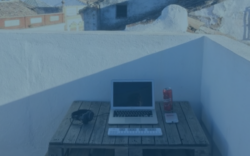Whether you’re just getting started producing and writing music or you’ve been doing it for years, collaborating is an extremely important skill to develop. It creates exciting new ideas and can result in a final product better than what one could do on their own.
But it does take some practice to get it right. Here are three methods to try out and see what
works best for you and your collaborators!
This blog post mentions Splice Studio, which is no longer active. Learn more about the shutdown here.
1. Top-lining
The first type of collaborating to try is known as “top-lining.” The “top line” is the lyrics and melody of the song. Here is a link to a great article about Ester Dean, one of the most successful to-liners in the business.
There are two roles to play with this type of collaborating – one role is to create the track/beat, the other is to write the lyrics/melody. Typically, a producer will create the track (with or without a hook) and a “top-liner” will create the lyrics/melody, and possibly the hook if needed.
This is a great method of collaborating that can either be done in the same room or half way around the world. Many of the collaborations I do that use Splice take this form because it is easy to pass tracks back and forth, add my part to them, and continue building on a track with other producers.
Here are a few tips if you’d like to try this method out:
- Try finding a person you’d like to collaborate with, see what other tracks they have released to get a sense of their style and create something that is in the same vein. This will stimulate your collaborators’ creative juices and you will have more success getting them excited to work on your track.
- If you’re a top-liner and don’t have a good recording setup to track your vocals, try to find a producer friend who is willing to engineer your sessions OR invest in a decent microphone/recording setup. The Audio Technica AT2020 is a really great and fairly inexpensive microphone that can really improve the quality of your recordings.1.
- If you’re a producer, have a bank of tracks ready to be written to and send a few options along to your collaborator. This will allow them more chances to find one that inspires something great.
2. Co-producing
The next type of collaborating is co-producing. This might be the messiest of all collaboration styles, but with the right group, it can yield amazing results.
Essentially, there are no rules when it comes to the collaboration process. Everyone is working toward the same goal: creating a great song. Someone might start singing a melody, another person might start jotting down lyrics to that melody, and a third person might jump in and offer a variation on that melody to make it better. As you can probably imagine, this requires extremely open communication and open minds.
Here are a few tips if you’d like to try this method out:
- This method works best with a smaller group of people. With too many people, it’s difficult to get everyone on the same page at times, which can cause things to move very slowly. Try it with one or two collaborators at first to get some practice.
- Keep an open mind and remember that everyone has the same goal: to create something great. If you take offense when someone says they don’t like an idea you threw out, you’re not going to be able to contribute to a healthy collaborative environment.
- This can be done really effectively using Splice Studio to pass sessions around. Because of the version control, everyone can take their session and run with it, ultimately allowing them to realize their vision and then present it for their collaborators to weigh in on. Try inviting a few producers to your sessions on Splice and see what they can bring to it to make it better!
3. Band writing
The final style of collaborating I’ll note is “band writing”. This style is exactly how it sounds – imagine you are in a rock band. There’s a drummer, guitarist, bassist, and singer. The singer might come to the band with some lyrics and melody. The guitarist starts playing chords that go well with it, and develops it into an interesting riff. The bass player follows the chord progression and adds in fills where appropriate. The drummer starts with a groove and embellishes it to make it unique. Before long, you’ve got a great song with a cool guitar part, tight drums/bass, and great vocals.
Essentially, each collaborator is very skilled at their specialty and they focus on making their part the best it can be. This can work really well for electronic music, too. Get together with your collaborators and let everyone claim an instrument / section to work on. Then, focus on making that section the absolute best it can be. Before you know it, you’ll have an awesome track.
Here are a few tips when creating in this style:
- Just because you’re in charge of your instrument doesn’t mean one of your collaborators won’t have a good idea for your part. Sometimes the best results of this form of collaborating are when the bass and drums work together to create a really cool fill into the chorus, for example.
- Always keep the good of the finished product in mind. This is very important in creating a cohesive song. Don’t go crazy on your synth riffs where it doesn’t make sense.
- Someone should ultimately have the final say about all of the parts. As long as you talk about this openly with your collaborators beforehand and come to an understanding together, there shouldn’t be any hard feelings down the road when that person makes an executive decision on a part.
Collaborating is all about communication. It’s a skill that needs to be practiced in order to be perfected. Splice is an incredible tool to get started working on tracks with other talented people around the world.
Are there any tips or styles of collaboration that I didn’t mention here? Anything that works for you?
November 6, 2017

.svg)
.svg)




